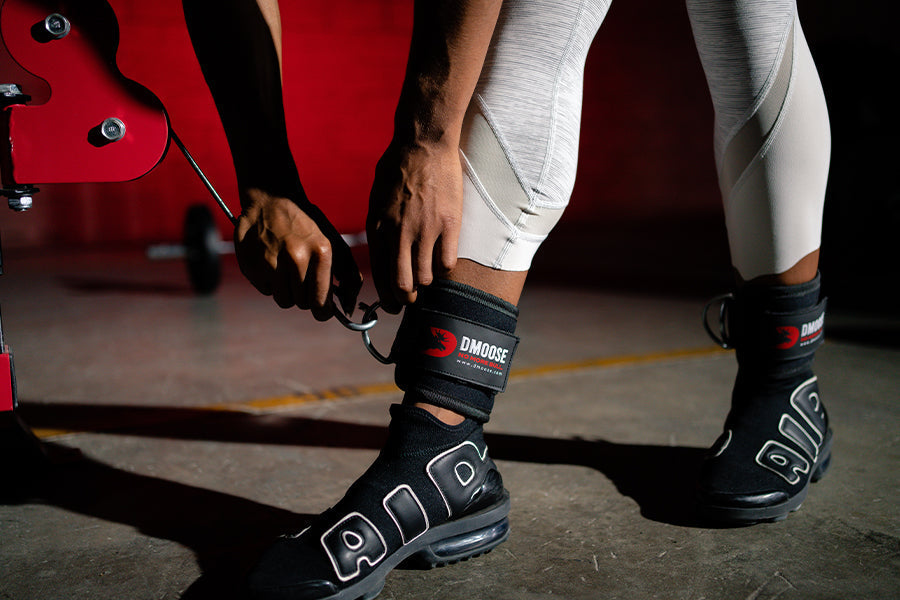Tired of endless squats that aren’t giving you the results you want? If your glute workouts have hit a plateau or you're just not seeing the lift, shape, and definition you’re after, it’s time to switch things up.
Cable machine exercises, especially when paired with a good cable ankle strap, offer constant tension, better range of motion, and precise glute targeting making them one of the most effective tools for building a round, strong, and sculpted booty.
In this guide, we’ll walk you through 12 cable workouts that will fire up your glutes and help you finally see the results you’ve been working for.
12 Cable Ankle Strap Exercises
These 12 cable machine exercises with ankle straps are designed to challenge your glutes, hamstrings, and quads with precision and intensity. All you need is a cable machine and a reliable pair of Ankle Bands to kickstart a more effective lower body training routine.
1. Cable Straight Leg Hip Flexions

This exercise effectively targets your hip flexors, quads, and glutes using steady cable resistance. It’s excellent for strengthening the front of your hips and thighs while boosting core stability, balance, and mobility.
Incorporating cable hip flexions into your routine can improve lower-body coordination and enhance athletic performance in movements like sprinting, kicking, or jumping. It’s a must-try for anyone aiming to tone their legs and develop strong, functional hips.
How to Perform Cable Straight Leg Hip Flexions
- Attach a cable ankle strap to one ankle and set the pulley to the lowest setting.
- Stand tall with your back facing the machine and your feet together.
- Keeping your working leg straight, slowly raise it forward to about a 45-degree angle.
- Pause briefly at the top while engaging your core and glutes.
- Lower your leg back down with control. Complete 12 reps, then switch sides.
2. Cable Inner Thigh Pulls
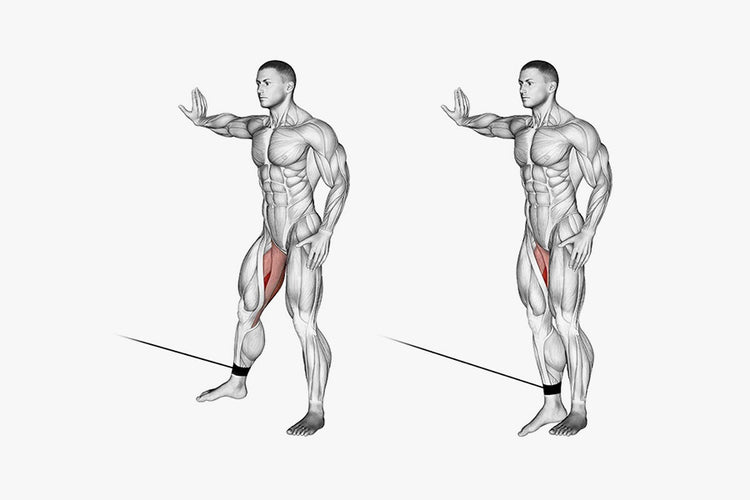
This move targets your adductors—those inner thigh muscles that are essential for lower body strength, stability, and control. It also activates your glutes, ensuring better support throughout the movement.
Adding inner thigh pulls to your training helps improve hip mobility and correct muscular imbalances—especially useful if your workouts tend to focus more on glutes and outer thighs. It’s ideal for building definition and strength in often-neglected areas.
How to Perform Cable Inner Thigh Pulls
- Attach an ankle strap to the leg closest to the pulley and set the cable to the lowest height.
- Stand sideways to the machine, keeping both legs straight.
- Pull your working leg across your body in front of the opposite leg until you feel tension in your inner thigh.
- Pause at the peak of the movement while maintaining muscle engagement.
- Slowly return to the starting position. Repeat for your set reps, then switch legs.
3. Cable Hip Abductions
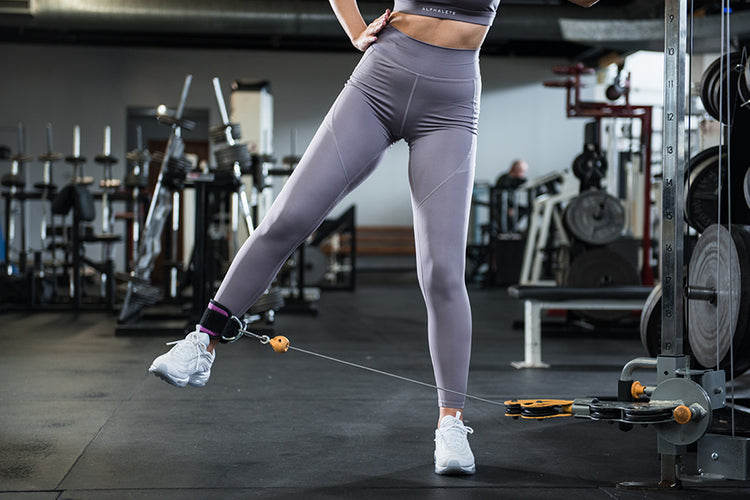
Cable hip abductions are a go-to glute builder, targeting the gluteus medius—the key muscle for outer hip strength and balance. This movement also works the lateral quads, helping define and tone the sides of your legs.
It’s an excellent exercise for improving lower body stability, correcting imbalances, and enhancing functional movements like walking, running, and climbing stairs. Include this in your workout to boost both aesthetics and athletic performance.
How to Perform Cable Hip Abductions
- Set the cable to its lowest point and attach the ankle strap to the leg farthest from the pulley.
- Stand sideways to the machine and hold on to the tower or a stable surface for support.
- With your leg straight, lift it out to the side until you reach about a 45-degree angle.
- Pause briefly at the top, focusing on squeezing your glutes.
- Lower your leg slowly to the starting position. Complete 12 reps, then switch sides.
4. Cable 45-Degree Kickbacks
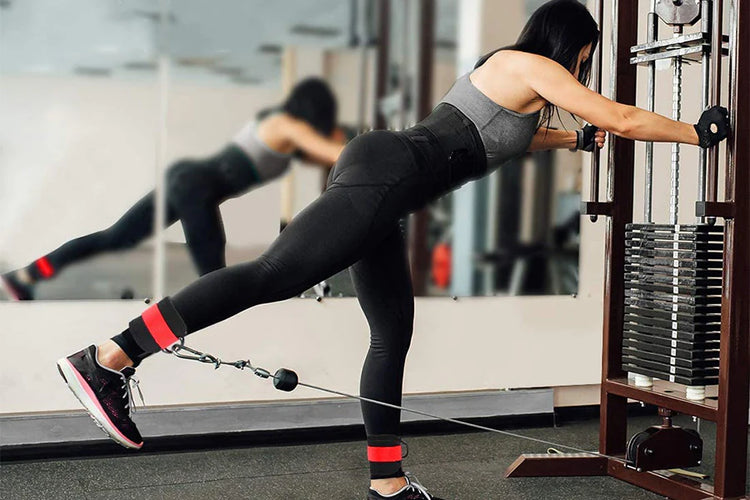
This glute-focused move also activates your hamstrings by driving your leg backward at a diagonal angle. The 45-degree path allows for greater muscle engagement and a fuller range of motion than standard kickbacks.
It’s a powerful addition for building rounder, more defined glutes and enhancing hip extension strength. Use this movement to isolate and grow your glutes with precision and control.
How to Perform Cable 45-Degree Kickbacks
- Attach an ankle strap to one leg and set the cable to the lowest pulley position.
- Face the machine, slightly bend your working knee, and hold the machine for balance.
- Kick your leg back at a 45-degree angle, focusing on glute contraction.
- Pause at the top, squeeze your glute, then return to the starting position slowly.
- Perform 12 reps, then switch legs.
5. Cable Standing Leg Extensions

This exercise isolates the quadriceps by focusing on knee extension, making it perfect for building front-thigh definition. It also helps strengthen the knee joint and improve lower-body stability.
Because it demands balance and control, it also enhances coordination and joint mobility—no machines or squats needed. A smart choice for anyone working toward strong, toned legs.
How to Perform Cable Standing Leg Extensions
- Attach the ankle strap to one leg and set the cable to the lowest setting.
- Stand facing away from the machine and use a stable object for support.
- Lift your leg, bend your knee to 90 degrees, then extend your leg forward by engaging your quads.
- Return to the bent position with control and begin the next rep without resting your foot.
- Complete 12 reps, then switch legs.
6. Cable Standing Hamstring Curls

This hamstring isolation exercise also recruits your glutes and core for balance and control. It’s an excellent alternative to traditional lying leg curls, especially if you're aiming to strengthen and sculpt the back of your thighs.
Standing curls engage more stabilizing muscles and challenge your coordination, making them highly effective for both strength and mobility. Add them to your routine to boost hamstring performance and lower-body definition.
How to Perform Cable Standing Hamstring Curls
- Set the cable to the lowest pulley and attach an ankle strap to one leg.
- Stand facing the machine and hold on for balance.
- Keep your thighs aligned and bend your working knee to lift your heel toward your glutes.
- Squeeze your hamstring at the top of the movement, then lower slowly with control.
- Repeat for 12 reps, then switch legs.
7. Cable Lying Down Hamstring Curls
This isolation exercise delivers a deep, focused contraction in your hamstrings while minimizing upper body engagement. It’s perfect for building strength and muscle definition in the back of your thighs with strict, controlled movement.
By lying down, you eliminate momentum and reduce strain on your lower back—making it a safer and more targeted alternative to standing curls. Ideal for anyone focused on hamstring development and overall lower-body performance.
How to Perform Cable Lying Down Hamstring Curls
- Set the cable to the lowest setting and attach ankle straps to both ankles.
- Lie face down on a yoga mat or bench, ensuring your legs can fully extend without slack.
- Begin with your legs straight and your core engaged for stability.
- Slowly bend your knees and curl your heels toward your glutes, squeezing your hamstrings at the top.
- Lower your legs back down with control and repeat for the desired number of reps.
8. Cable Reverse Lunges
Cable reverse lunges provide constant tension through every phase of the movement, activating your glutes, quads, and calves with greater intensity. Compared to forward lunges, this variation places less stress on the knees and challenges your balance and control.
It’s a powerful way to build unilateral strength, correct imbalances, and improve lower-body coordination. The controlled resistance from the cable machine helps sculpt stronger, more defined legs and glutes.
How to Perform Cable Reverse Lunges
- Set the cable to the lowest pulley and attach the ankle strap to one leg.
- Stand facing the machine with feet hip-width apart and core engaged.
- Step backward with the strapped leg into a deep lunge, bending both knees to 90 degrees.
- Drive through the front heel to return to the starting position.
- Perform 10 reps per leg, then switch sides.
9. Cable Lateral Lunges

Cable lateral lunges are a dynamic move that targets your glutes, quads, and inner thighs while improving hip mobility and flexibility. This side-to-side motion strengthens the adductors—key muscles often overlooked in typical leg workouts.
It’s a great way to enhance balance, coordination, and full-leg development. Plus, the cable resistance adds intensity, helping you shape sculpted glutes and a more athletic lower-body physique.
How to Perform Cable Lateral Lunges
- Set the cable to the lowest pulley and attach the ankle strap to the leg farthest from the machine.
- Stand sideways to the machine with feet shoulder-width apart.
- Step the strapped leg out into a lateral lunge, bending at the knee while keeping the other leg straight.
- Push off the working leg to return to the starting position.
- Complete 10 reps, then switch sides.
10. Cable Squats
Cable squats engage your glutes, quads, and hamstrings while delivering constant resistance that promotes better control and deeper range of motion. Unlike bodyweight squats, the cable adds tension throughout the entire movement.
This variation is perfect for improving form and posture, especially for beginners or anyone looking to switch up their leg routine. It’s a great way to build lower-body strength, boost balance, and tone your legs and glutes.
How to Perform Cable Squats
- Set the cable to the lowest pulley and attach the handle or ankle strap as needed.
- Stand with feet hip-width apart, facing the machine, and hold the cable for support.
- Lower into a squat by hinging your hips back and bending your knees until thighs are parallel to the ground.
- Keep your core braced and chest lifted as you press through your heels to return to standing.
- Repeat for 10 slow, controlled reps.
Related Article: Strong Glutes - 8-Week Booty Burner Workout
11. Cable Single-Leg Mountain Climbers
This explosive move fires up your glutes, core, and hamstrings while adding resistance to a classic bodyweight exercise. The cable tension increases intensity, making each rep more challenging and effective.
It also boosts hip mobility, core stability, and total-body endurance—perfect as a finisher or for high-intensity circuits. You’ll feel the burn while building strength and control through your lower body.
How to Perform Cable Single-Leg Mountain Climbers
- Attach the ankle strap to one leg and set the cable to the lowest point.
- Get into a high plank position, shoulders over wrists, core tight.
- Drive the strapped leg forward toward your elbow, maintaining control.
- Slowly extend it back to the starting position without losing tension.
- Alternate sides after every 2 reps, continuing for your desired round.
12. Cable Donkey Kick
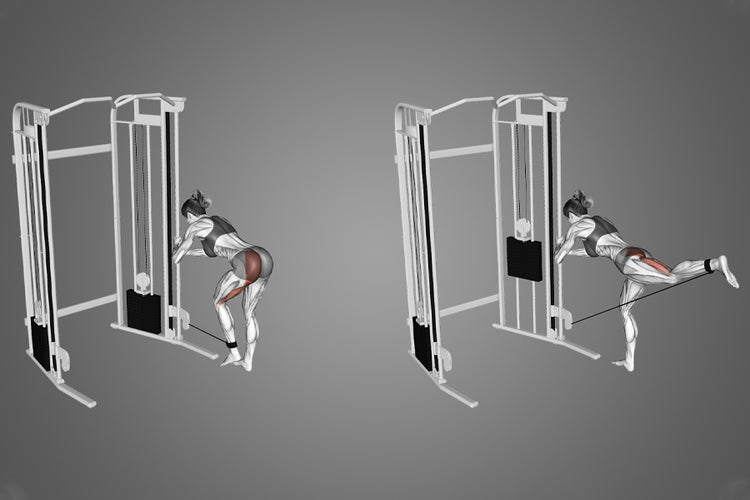
Cable donkey kicks are a powerhouse glute isolation move that delivers serious burn and growth. The constant resistance increases glute activation and helps build roundness, strength, and definition in your backside.
This exercise also strengthens your core and improves hip mobility, making it a go-to for anyone working toward stronger, more sculpted glutes.
How to Perform Cable Donkey Kick
- Attach an ankle strap to the lowest pulley and secure it to one leg.
- Kneel facing the cable machine, bracing yourself with your hands or the tower for support.
- Kick your working leg back and upward, keeping your knee slightly bent.
- Squeeze your glute at the top, then return to the start with control.
- Complete 10 reps on one side, then switch legs.
Conclusion
Cable ankle strap exercises are unmatched when it comes to sculpting a strong, balanced, and aesthetic lower body. These targeted movements don’t just activate your muscles, they help refine them with precision, control, and consistency.
From deep glute engagement to well-defined quads and hamstrings, the workouts in this guide offer a powerful blueprint for lower-body transformation. Each rep builds toward better symmetry, strength, and athletic performance.
Embrace the versatility of cable training, push past your limits, and train with purpose. With consistency, proper form, and the right tools like a quality cable ankle strap, you’re not just working out; you’re building the best version of yourself.
Reading List
Article Sources
- Jeon, In-cheol, et al. "Ankle-Dorsiflexion Range of Motion After Ankle Self-Stretching Using a Strap." Journal of Athletic Training, vol. 50, no. 12, Dec. 2015, pp. 1226-32. PubMed Central, https://doi.org/10.4085/1062-6050-51.1.01.
- Wilkerson, Gary B. "Biomechanical and Neuromuscular Effects of Ankle Taping and Bracing." Journal of Athletic Training, vol. 37, no. 4, 2002, pp. 436-45. PubMed Central, https://www.ncbi.nlm.nih.gov/pmc/articles/PMC164375/.








